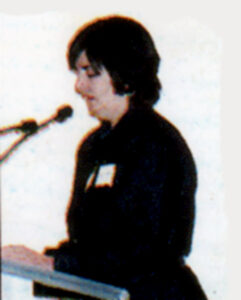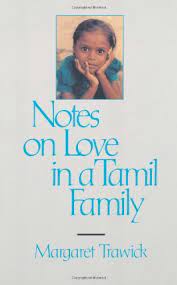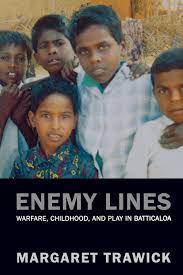by Sachi Sri Kantha, January 23, 2022

Prof. Margaret Trawick
Among Eelam Tamils, a few Tamil women academics such as Dr. Rajani Thiranagama (1954-1989) and Radhika Coomaraswamy (b. 1953) wrote anti-LTTE tracts, for their personal glory as beacons of human rights. But, Professor Margaret Trawick (1948-2022), though not being born as a Tamil, contributed her energy as an authentic anthropologist, to counter the sentiments expressed by the likes of Thiranagama and Coomaraswamy. In her immersed knowledge of Tamil culture, she also differed from the American women journalists and academics, whom I humorously tagged as ‘Six Blind Women of Gringo Land’ [see my 2010 posting in this site, https://sangam.org/2010/03/Blind_Women.php?uid=3867]
I first came to know the name Margaret Trawick, when I bought a paperback copy of her classic book, ‘Notes on Love in a Tamil Family’ in 1992, after the birth of my second daughter Sangita. What she had presented in her book, about how Tamils understand the word ‘Anbu’ (love) captivated me, and inclusion of lyricist Kannadasan’s immortal lines for the tear jerker Pasa Malar (1961) movie informed me that here was an exceptional American anthropologist, who had taken the trouble to learn the Tamil language/literature first, prior to writing about Tamils. To tag a popular Tamil idiom, Margaret was a no ‘surface grazing goat’. My review of her book first appeared in the Tamil Nation (print edition) in May 1993. Later, it had been posted in the digital version of Tamil Nation, and in the Sangam site as well. [https://sangam.org/2011/05/Love_Tamils.php?uid=4354]
 From her interactions with her Tamil mentor S.R. Themozhiyar’s family in Chennai, for 18 months between 1975 and 1976, Margaret learnt about what components constitute ‘love’ for Tamils. She identified 9 components, which are, containment (adakkam), habit (pazhakkam), harshness and cruelty (kadumai and kodumai), dirtiness (azhukku), humility (panivu), poverty and simplicity (ezhumai and elimai), servitude (adimai), opposition and reversal (ethirttal and puratchi), mingling and confusion (kalattal and mayakkam). The last sentence of my review of this book was, ‘I believe Margaret Trawick had written a worthy book on a worthy topic about Tamils.’ And I was not alone in identifying its merit.
From her interactions with her Tamil mentor S.R. Themozhiyar’s family in Chennai, for 18 months between 1975 and 1976, Margaret learnt about what components constitute ‘love’ for Tamils. She identified 9 components, which are, containment (adakkam), habit (pazhakkam), harshness and cruelty (kadumai and kodumai), dirtiness (azhukku), humility (panivu), poverty and simplicity (ezhumai and elimai), servitude (adimai), opposition and reversal (ethirttal and puratchi), mingling and confusion (kalattal and mayakkam). The last sentence of my review of this book was, ‘I believe Margaret Trawick had written a worthy book on a worthy topic about Tamils.’ And I was not alone in identifying its merit.
I have counted at least four positive reviews for Margaret’s ‘Notes’ book published in academic journals, all applauding her contribution to anthropology. Few sentences from two of these are provided here. Clifford Hospital (Pacific Affairs, winter 1992-93, pp. 582-584) wrote, “This is an extraordinary book. Quite simply, it is one of the finest scholarly books I have ever read…What is exceptional is Margaret Trawick’s approach. First, she has elected to study in great detail a single extended family of twenty members. To this task, she brings a knowledge of nuances of colloquial Tamil, an extensive study of Tamil literature and a familiarity with religious practices and the associated mythologies and theologies. Second, she has given a quite new meaning to the scholarly status of ‘participant observer’…” R.S. Khare (American Ethnologist, August 1992, pp. 611-612) noted, “This is one of the finest recent ethnographies on India, dealing with the subject – love and emotions – most often bypassed in favor of the more familiar issues of caste, ritual and politics. The book is doubly appealing because it achieves so much so unpretentiously for anthropological theory of representation – now a critical issue…”
Margaret’s 1978 Ph.D dissertation submitted to the University of Chicago was entitled, ‘The Sacred Spell and other conceptions of Life in Tamil Culture’.
 If ‘Notes on Love in a Tamil family’ was Margaret’s tribute to Tamil culture in Tamil Nadu, Eelam Tamils received their garland from Margaret 17 years later with her work, ‘Enemy Lines: Warfare, Childhood and Play in Batticaloa’ (2007). She had visited Batticaloa for the first time in March 1996. I reproduce two paragraphs from the review by Mark P. Whitaker of this book, published in the Journal of Asian Studies (May 2009, pp. 662-664).
If ‘Notes on Love in a Tamil family’ was Margaret’s tribute to Tamil culture in Tamil Nadu, Eelam Tamils received their garland from Margaret 17 years later with her work, ‘Enemy Lines: Warfare, Childhood and Play in Batticaloa’ (2007). She had visited Batticaloa for the first time in March 1996. I reproduce two paragraphs from the review by Mark P. Whitaker of this book, published in the Journal of Asian Studies (May 2009, pp. 662-664).
“..Trawick, aware that she is treading on shifty ground, nevertheless expresses sympathy for the LTTE’s cause (if not at all for its tactics or organization) because, as she outlines in useful introductory chapters, the repression and extreme violence that Sri Lankan Tamils have suffered (and continue to suffer) at the hands of various Sri Lankan governments have been well documented. In any case, Trawick’s initial mission, as she recounts it, was twofold: to come to some understanding of the ‘worldviews’ of people, especially children and young women, who have lived their entire lives in a war zone; and second, more controversially, to test and perhaps push beyond the simplistically demonizing portraits of male and female LTTE cadres put forward by their political and military opponents, who generally represent the Tigers – as LTTE cadres are called – as steely-eyed, cyanide-wearing terrorists fanatically devoted to their leader, the infamous Velupillai Prabhakaran. In this elegant if understandably wary book, Trawick, with great verve, successfully pulls off both these tasks. At the same time, she is wise enough to allow her account to force some theoretical and, frankly, moral questions about the nature of warfare and ethnography that, perhaps, ultimately have no answers – but are worth addressing nonetheless.
Given the tricky subject matter, some will fault Trawick for being too sympathetic to the Tigers, too ‘reflexive’ (in that she does not exempt herself from the narrative), and too ethically compromised by her attempt to complicate previous discussions of the LTTE’s female and child soldiers. But I think Trawick handles these issues well. First, although she is honest about her sympathy for the Tiger cause, Trawick does not seem to have been so influenced as to cover up painful details about Tiger practices in the Batticaloa district. Second, Trawick’s reflexivity, as she points out, is not confessional and avoids fingernails-on-the-blackboard self-absorption; she simply uses herself, quite effectively, as a foil. Third, Trawick’s discussions with female and young LTTE cadres are quite nuanced. Trawick’s interviews with some of the ‘Birds of Freedom’ (as the LTTE calls its female cadre) reveal women who are far more complicated than their representation by either the LTTE or their detractors would suggest. Trawick’s discussion of child soldiers is also helpful. While not condoning the LTTE’s use, sometimes, of children as young as thirteen, she correctly identifies this as part of a worldwide phenomenon related to global poverty, changes in small-arms technology, and the well-known malleability of the young – and points out that current international human rights law prohibits only non-state groups, not states (e.g., Sri Lanka, the United States), from recruiting children younger than eighteen…”

Peggy Trawick 1996
Another reviewer of this ‘Batticaloa book’ (Journal of Royal Anthropological Institute, Dec. 2009, pp. 870-871), Alexandra Argenti, who had acknowledged that ‘I was in the field at the same time, working in a Sinhalese village on the other side of the frontline’ also was very positive about Margaret’s work in Batticaloa. Excerpts from two paragraphs of this review are presented below:
“…It is not easy to put down this ethnography even after the last page has engrained itself on the reader’s memory…For people who lived or worked in Sri Lanka at the time these data were gathered (1996-2002), the names of battles, towns, suicide bombings, and operations have an emotional impact of their own. Riviresa, Jayasikurui, Mulaitivu, Kilinocchi, Temple of Tooth, Independence Day 1998, Maradana; all spatio-temporal markers of horror, which form a backdrop to Trawick’s courageous ethnography.
The author operated within a Tiger-controlled area, across the lagoon at Batticaloa, in Eastern Sri Lanka. A small step away from the inaccessible theatres of war in the Jaffna peninsula and the Vanni region, Trawick carefully constructed an ethnographic niche in the village of Kokkadichcholai, where fear for her life became manageable. Yet neighbouring villages were not spared regular raids, round-ups, disappearances, and bombings by Special Task Forces of the Sri Lankan national army. A fragile and unspoken truce emerged between an anthropologist and death squads, yet only for as long as it was strictly necessary. As Trawick emerged from her field site and was on a bus from Batticaloa to the capital Colombo to return home, the Sri Lankan army attacked the village of Kokkadichcholai and killed and maimed many…”
Apart from Margaret’s books, two of her early studies in medical anthropology (published in Social Science and Medicine journal) were thought-provoking. Both were based on her field work in Tamil Nadu. In her 1983 paper entitled, ‘Death and nurturance in Indian systems of healing’, Margaret examined four different indigenous healing traditions practiced by Tamils. These were, (1) Ayurveda – the classical Sanskrit system of medicine, (2) Tamil Saiva bhakti (devotional worship of Lord Siva), (3) Siddha medicine practiced in Tamil Nadu, and (4) Trans-healing by mediums paying allegiance to folk goddess Mariamman. She inferred that all four systems form a gradient in how they evaluate the feminine sex. According to her interpretation, Saiva bhakti and Siddha medicine form the left and right extreme ends. Ayurveda and Trans-healing by mediums lie in between these two extremes. According to Margaret’s interpretation,
Saiva bhakti – ‘virtually deifies the feminine as the embodiment of love, meltingness and self-sacrifice.’
Ayurveda – ‘accepts feminine process as necessary for the evolution and liberation of the masculine entity’
Trans-healing by mediums – hangs between ‘espousal of the feminine ideal and denial of its validity’
Siddha system – ‘excludes the feminine from its sphere of being’.
In a 1987 paper, entitled ‘The Ayurvedic Physician as scientist’, Margaret described in detail, the thought and practice of a typical Ayurvedic physician Mahadeva Iyer from Tamil Nadu. Towards the end of this study, Margaret commented on a prevailing conflict.
“The conflict between classical Brahmanism and Tamil Saktism rests in part on a discrepancy between a vision of the world as organized around hierarchical principles of purity, and the world as maintained by the messy dynamics of procreation. In texts more oriented toward the former (Manavadharmasastra, Tirumantiram) females are described, at best, as means towards ends, and at worst, as foul creatures honored by shackles. For thinkers more oriented toward the latter (Tiruvalluvar, Sankara, Ramanuja, Bharatiyar, Annadurai), the equation between motherhood and godhead prevails. This kind of polarity is of course not confined to India, but in India it is particularly elaborated.”
I cannot miss mentioning Margaret’s long paper published in the Cultural Anthropology journal in 1988 – a tour de force tribute to Saint Manikavasagar’s 400 stanza poem ‘Thirukovaiyar’ and to her Tamil mentor S.R.Themozhiyar. Though she mentions that Manikkavasagar was a ‘10th century Saiva saint, who is generally regarded as the greatest of the South Indian devotional poets’, current scholarship dates his period as belonging to the 9th century. This is because, Manikkavasagar served as a minister to the Pandya king Varagunavarman II, whose period is dated AD 862 – 879. It deserves mention that Manikkavasagar played a significant role in establishing Hindu Saivism as a dominant religion in Tamil Nadu, by his feats of debating and converting Buddhist Tamils of that era.
On a personal note, I couldn’t meet Margaret face-to-face due to physical distance, and the personal inconvenience I suffered in being listed in the notorious NFL list of the mid 2000s, while being a Sri Lankan passport holder. But I had the pleasure to correspond with her via email a couple of times. I solicited a critical review from her for my 2005 book on Prabhakaran. Though she agreed to write one, eventually it didn’t turn into a reality. I vividly remember the lines of her email, stating that she was in transit on her way to Sri Lanka, and found the details presented in my book quite interesting for her own research. I refrained from pushing her for the review she had promised to do. Though the physical frame of Margaret has left this world, her spirit continues to live in her books and research papers about the Tamil culture in Tamil Nadu and Eelam.
Also, check my Front Note to Margaret Trawick’s criticism of Prof. Rohan Gunaratna, posted in 2012. https://sangam.org/2012/07/Threat_World_Order.php?uid=4777
Representative Research Publication List of Margaret Trawick
Egnor M: On the meaning of sakti to women in Tamil Nadu. In: The Powers of Tamil Women, Susan Wadley (ed.), Maxwell School Foreign and Comparative Studies series, Syracuse University Press, Syracuse, 1980, pp. 1-34.
Trawick Egnor M: Death and nurturance in Indian systems of healing. Social Science and Medicine, 1983; 17(14): 935-945.
Trawick Egnor M: review of ‘Medusa’s Hair: an essay on personal symbols and religious experience’ by Gananath Obeyesekere. Journal of Asian Studies, 1983; 42(2): 442-444.
Trawick Egnor M: A response to Gananath Obeyesekere. Journal of Asian Studies, 1983; 42(4): 890-891.
Trawick Egnor M: The changed mother, or what the smallpox goddess did when there was no more smallpox. Contributions to Asian Studies, 1984; 18: 24-45.
Trawick Egnor M: Internal iconicity in Paraiyar crying songs. In: Another Harmony – New Essays on the Folklore of India, A.K. Ramanujan and Stuart Blackburn (Eds), University of California Press, Berkeley, 1986, pp. 294-344.
Trawick M: The Ayurvedic physician as scientist. Social Science and Medicine, 1987; 24 (12): 1031-1050.
Trawick M: Ambiguity in the oral exegesis of a sacred text Tirukkovaiyar (or, the Guru in the Garden, being an account of a Tamil informant’s responses to homesteading in central New York state). Cultural Anthropology, Aug 1988; 3(3): 316-351.
Trawick M: Spirits and voices in Tamil songs. American Ethnologist, May 1988; 15(2): 193-215.
Trawick M: Review of ‘Laughing Matters: Comic Tradition in India’ by Lee Siegel. American Ethnologist, Feb 1989; 16(1): 175-176.
Trawick M: Review of ‘Singing of Birth and Death: Texts in Performance’ by Stuart H. Blackburn, American Ethnologist, Aug 1989; 16(3): 573-574.
Trawick M: The ideology of love in a Tamil family. In: Divine Passions: The social construction of emotion in India, O.M. Lynch (ed) University of California Press, Berkeley, 1990, pp. 37-63.
Trawick M: Notes on Love in a Tamil Family, University of California Press, Berkeley, 1990, 299 pp.
Trawick M: An Ayurvedic theory of cancer. In: Anthropological approaches to the study of ethnomedicine, M. Nichter (ed), Gordon and Breach Publishers, Yverdon, Switzerland, 1992, pp. 207-222.
Trawick M: Death and nurturance in Indian systems of healing. In: Paths to Asian Medical Knowledge, C. Leslie and M. Lock (eds.), University of California Press, Berkeley, 1992, pp. 129-159.
Trawick M: Writing the Body and Ruling the Land: Western reflections on Chinese Medicine and Indian Medicine. In: Knowledge and Scholarly Medical Traditions, D. Bates (ed), Cambridge University Press, Cambridge, 1995, pp. 279-296.
Trawick M: Review of 4 books by Steven M. Parish, David Ludden, Shahid Amin and Veena Das. Indian Blood: New Lessons in Hindu Statecraft. American Anthropologist, Jun 1998; 100(2): 526-529.
Behera DK, Trawick M: Children and childhood in metropolitan cultures: an introduction. International Journal of Anthropology, 2001; 16(2-3): 57-64.
Trawick M: Enemy Lines; Warfare, Childhood and Play in Batticaloa, University of California Press, Berkeley, 2007, 320 pp.
Trawick M: Death, Beauty, Struggle – Untouchable Women Create the World, University of Pennsylvania Press, Philadelphia, 2017, 304 pp.